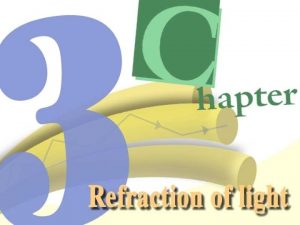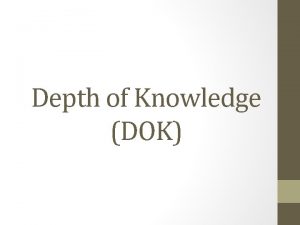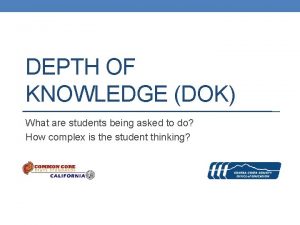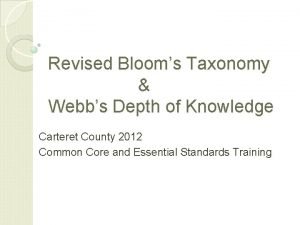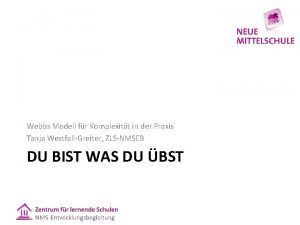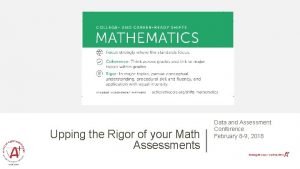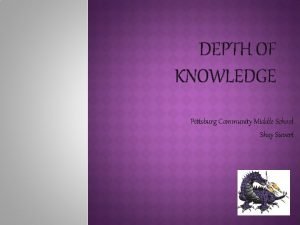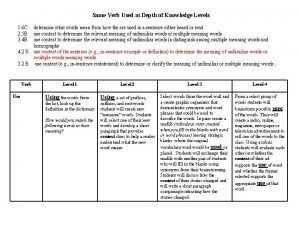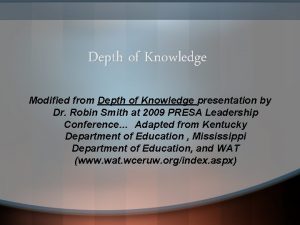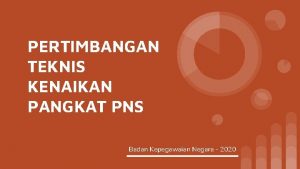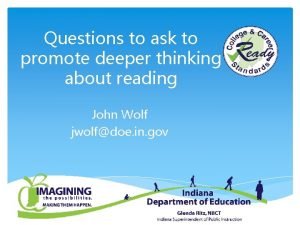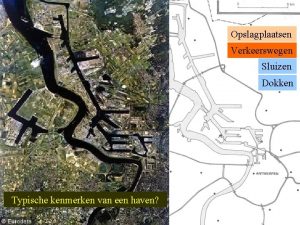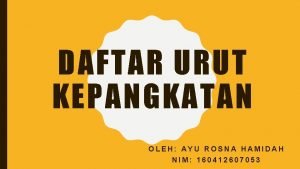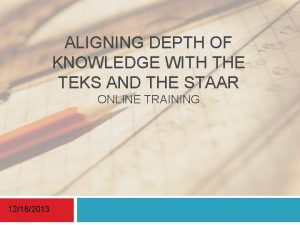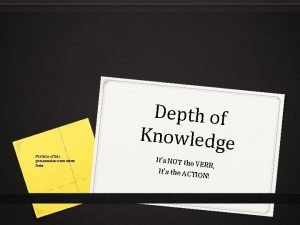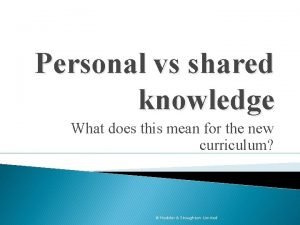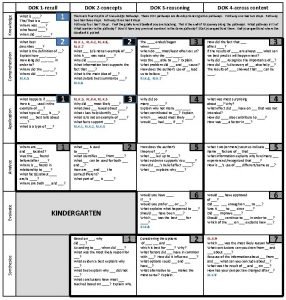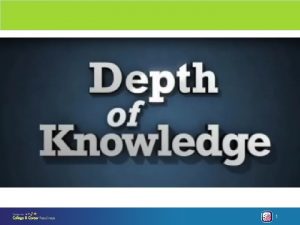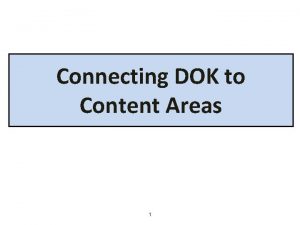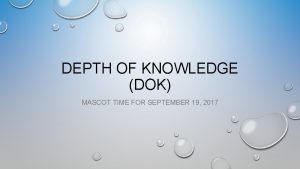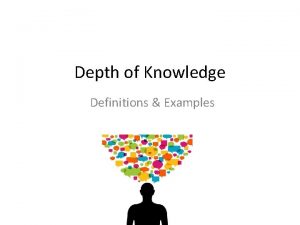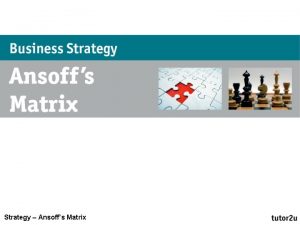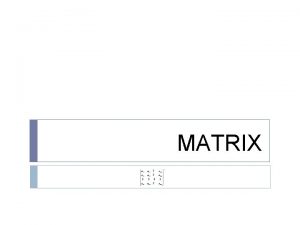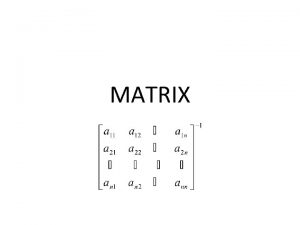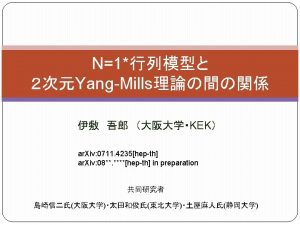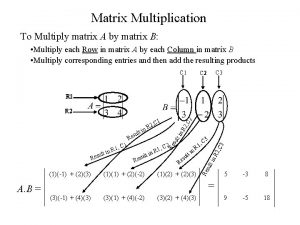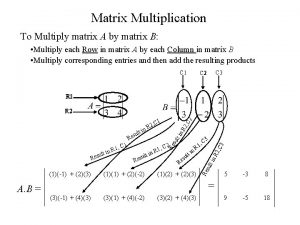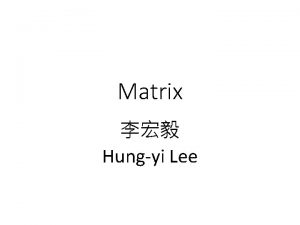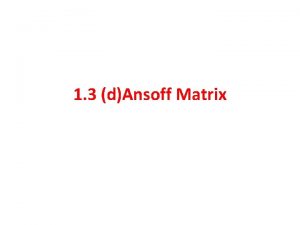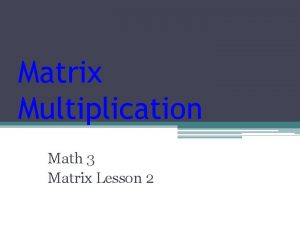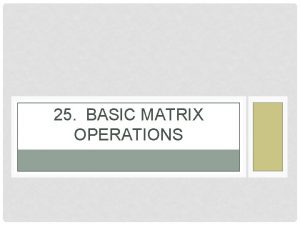The Depth of Knowledge DOK Matrix What do
























- Slides: 24

The Depth of Knowledge (DOK) Matrix What do I Need to Know? • Each Common Core State Standard has an assigned DOK • The DOK Matrix can guide instruction and instruction assessment • The Depth of Knowledge Matrix integrates Depth of Knowledge Matrix Webb’s DOK’s and Bloom’s Taxonomy. Webb’s DOK’s Bloom’s Taxonomy • The DOK Matrix is used to create Learning Progressions for each standard. Learning Progressions Assessment writers for CCSS use the DOK Matrix (combining Blooms and Depth of Knowledge) to close the gap between how we expect students to think (Bloom’s) and the evidence of that thinking (Webb’s). 1

Blooms Taxonomy and Webb’s Depth of Knowledge – kind of task. Webb’s DOK 1 Recall and Reproduction 2 Skills and Concepts 3 Short term Strategic Thinking 4 Extended Thinking Bloom’s Taxonomy Knowledge Comprehension Application Analysis Evaluation Synthesis (remembering) (understanding) (applying) (analyzing) (evaluating) (creating) Blooms – the thinking approach needed to complete a task. 2

Each color in this table represent a DOK target. Webb’s DOK 1 Recall and Reproduction 2 Skills and Concepts 3 Short term Strategic Thinking and Reasoning 4 Extended Thinking Bloom’s Taxonomy Knowledge Comprehension Application Analysis Evaluation Synthesis (remembering) (understanding) (applying) (analyzing) (evaluating) (creating) Watch as Bloom’s Taxonomy and Webb’s Depth of Knowledge form the DOK Matrix. 3

DOK LEVEL 1 Recall and Reproduction Knowledge (Remember) Recall, locate basic facts, definitions, Comprehension details and events (Understand) DOK 2 Skills and Concepts Apply (Applying) Select appropriate words for use when intended meaning is clearly evident. -Specify, explain Use language structure(pre/suffix) or word relationships (synonyms/antonym) to determine meaning. - Identify the kind of information contained in a graphic, table, visual, etc. -Brainstorm ideas, concepts, problems, or perspectives related to a topic or concept. DOK LEVEL 3 Reasoning and Thinking Analysis (Analyzing) Evaluate (Evaluating) DOK 4 Extended Thinking Synthesize (Creating) Explain, generalize or connect ideas using supporting evidence (quote, text, evidence). -Explain how concepts or ideas specifically relate to other content domains. -Use context to identify word meanings -Obtain and interpret information using text features. -Use concepts to solve non-routine problems. Devise an approach among many alternatives to research a novel problem. -Compare literary elements, facts, terms and events. -Analyze format, organization & text structures. -Analyze or interpret author’s craft (e. g. , literary devices, viewpoint, or Potential bias) to critique a text. Analyze multiple sources or multiple text. -Analyze complex abstract themes. -Cite evidence and develop a logical argument for conjectures based on one text or problem. -Evaluate relevancy, accuracy and completeness of information across texts or sources relationships -Summarize -Identify central ideas -Generate conjectures or hypotheses based on observations or prior knowledge and experience. -Synthesize information -Develop a complex model or approach for a given situation. -Develop an alternative solution. across multiple sources or texts. -Articulate a new voice, theme, knowledge or perspective. Bloom’s Taxonomy and Webb’s DOK form a Cognitive Matrix 4

A Completed DOK Matrix Showing Paths and End Target Goals Webb’s Depth of Knowledge DOK LEVEL 1 Recall and Reproduction DOK LEVEL 2 DOK LEVEL 3 Basic Skills and Concepts Strategic Thinking and Reasoning DOK LEVEL 4 Extended Thinking Blooms Remember (Knowledge) -Recall, locate basic facts, definitions, details and events -Select appropriate words for use when intended meaning is clearly evident. -Specify, explain relationships -Summarize -Identify central ideas -Explain, generalize or connect ideas using supporting evidence (quote, text, evidence). -Explain how concepts or ideas specifically relate to other content domains. Apply -Use language structure(pre/suffix) or word relationships (synonyms/antonym) to determine meaning. -Use context to identify word meanings -Obtain and interpret information using text features. -Use concepts to solve nonroutine problems. -Devise an approach among many alternatives to research a novel problem. Analyze - Identify the kind of information contained in a graphic, table, visual, etc. -Compare literary elements, facts, terms and events. -Analyze format, organization and text structures. -Analyze or interpret author’s craft (e. g. , literary devices, viewpoint, or potential bias) to critique a text. -Analyze multiple sources or multiple text. -Analyze complex abstract themes. -Cite evidence and develop a logical argument for conjectures based on one text or problem. -Evaluate relevancy, accuracy and completeness of information across texts or sources -Develop a complex model or approach for a given situation. -Develop an alternative solution. -Synthesize information across multiple sources or texts. -Articulate a new voice, theme, knowledge or perspective. Understand (Comprehend) Evaluate Create (Synthesize) -Brainstorm ideas, concepts, problems, or perspectives related to a topic or concept. -Generate conjectures or hypotheses based on observations or prior knowledge and experience. 5 2009 ©Karin K Hess, Hess Cognitive Rigor Matrix – Permission to reproduce is given when authorship is fully cited.

2. The DOK Matrix Instructional Paths Four Instructional Paths Selected Response DOK 1 DOK 2 Recall and Reproduction Knowledge (remembering) Comprehend understanding Apply Each standard has an assigned Depth of Performance Constructed Response Task Knowledge. Skills and Concepts Recall, locate basic facts, definitions, details and events Extended Thinking DOK 3 Reasoning and Thinking Select appropriate words for use when intended meaning is clearly evident. -Specify, explain relationships -Summarize -Identify central ideas Use language structure(pre/suffix) or word relationships (synonyms/antonym) to determine meaning. Analyze The DOK determines the cognitive level of instruction. DOK 4 Devise an approach among many alternatives to research a novel problem. -Use concepts to solve non-routine problems. Compare literary elements, facts, terms and events. -Analyze format, organization and text structures. -Analyze or interpret author’s craft (e. g. , literary devices, viewpoint, or potential bias) to critique a text. -Cite evidence and develop a logical argument for conjectures based on one text or problem. Evaluate Creating (Synthesizing) Explain, generalize or connect ideas using supporting evidence (quote, text, evidence). -Use context to identify word meanings -Obtain and interpret information using text features. - Identify the kind of information contained in a graphic, table, visual, etc. -Explain how concepts or ideas specifically relate to other content domains. -Brainstorm ideas, concepts, problems, or perspectives related to a topic or concept. -Generate conjectures or hypotheses based on observations or prior knowledge and experience. -Develop a complex model or approach for a given situation. -Develop an alternative solution. Analyze multiple sources or multiple text. -Analyze complex abstract themes. -Evaluate relevancy, accuracy and completeness of information across texts or sources -Synthesize information across multiple sources or texts. -Articulate a new voice, theme, knowledge or perspective. 6

Placement of Grade 4 Informational Text Standards on the DOK Matrix Click only once at the beginning of this slide and then again after the last standard moves to its place. RI. 4. 1 RI. 4. 3 RI. 4. 1 RI. 4. 2 RI. 4. 3 RI. 4. 4 RI. 4. 7 RI. 4. 5 RI. 4. 6 RI. 4. 7 RL. 4. 9 RL. 4. 8 RL. 4. 9

The Pacing Guides list each Common Core State Standard’s assigned Depth of Knowledge (DOK) level. Grade 4: Literary Text (RL) and DOKs Standard 1 2 Grade 4 1, 2 2 3 4 5 Informational Text (RI) and DOKs 6 2, 3 1, 2 2, 3 3, 4 7 8 9 10 3 N/A 4 N/A 1 2 1, 2 2 3 4 5 2, 3 1, 2 2 6 7 3, 4 2, 3 8 9 10 3 4 N/A DOK 1 Blue DOK 2 Green DOK 3 Orange DOK 4 Red There are no CCSS Reading Standards listed as having only a DOK of 1. Standards with a DOK of 1 are listed as DOK 1, 2. The highest level of cognitive demand for 8 those standards would be considered a “ 2. ”

Why Does it Matter? If we know the DOK level of each standard, we can work backwards and create the small sequential steps called learning progressions the predicted set of skills needed to be able to complete the required task demand of each standard. 9

Learning Progressions Example for Standard RI. 4. 8 Depth of Knowledge 3 Learning Progressions for RI. 4. 8 Assessments Selected Response Selected and Constructed Responses Reading Informational Text CCSS: RI. 4. 8 Cognitive Learning Progression Targets RI. 4. 8 Students explain how _____uses reasons and evidence in the book, _______, to support particular points in the text about___. DOK – 1 – Pre. Grade 4 1 2 3 4 5 6 7 DOK – 2 Pre-Requisites Assessments at this level have evidence of evidence basic recall of understanding skills and concepts. facts, events or simple processes. DOK Guide g Identify specific RI. 4. 8 Explain how RI. 4. 8 information on a an author uses graphic (chart, reasons and table, etc…). evidence to support particular points in a text Student NAME Performance Task Prompt for RI. 4. 8 Categorize events in the text for a purpose (interpret) Analyze text structure to locate supporting evidence Distinguish relevant from irrelevant information DOK – 3 - Target Assessments at this level need to have evidence of strategic reasoning using textual evidence as support. Make logical connections using text evidence Use evidence to reason (concept) about a problem Describe how word choice, point of view, or bias may affect the readers’ interpretati on of a text Analyze interrelati onships among concepts, issues and problems Use reasoning, planning, and evidence to support inferences 10

Pacing Guide by Quarter Example of DOK Path 3 Standard RI. 4. 8 has an assigned DOK of 3. How might instruction look following the DOK 3 path? Unit of Study #5 - Informational Text Quarter 3 Overview: Students prepare to write a short research paper based on an historical figure. They interpret with evidence and reason to support a topic and draw conclusions (ELP Target) They plan using a graphic organizer drawing evidence from texts and technological tools. Students revise their writing with correct capitalization. They link ideas within categories using words and phrases. Reading Skill: Making Judgments Reading Strategy: Monitor/Clarify E. L. P. Target Interpreting (Conclusions) Function: Explaining Interpret: implicit meaning & propaganda (exaggeration) comparative adj: er, -est, E. L. P. Target does/does not, adverbs of degree (quite, too) and manner (-ly), Forms: Explain: in, is, I came, I ___(ed), had, but, (adverbs of manner), then, as a result of, I Read to support a point using reasons and evidence. RI. 4. 8 Explain how an author uses reasons and evidence to support particular points in a text (supports ELP Target – Explain). Ask: How does the author support the point about ___ with reasons and evidence (supports ELP Target – Interpret). Standard RI. 4. 8 Follows DOK Path 3 Analyze Evaluate - Identify the kind of information contained in a graphic, table, visual, etc. Compare literary elements, facts, terms and events. -Analyze format, organization and text structures. DOK LEVEL 3 Reasoning and Thinking Explain, generalize or connect ideas using supporting evidence (quote, text, evidence). -Use concepts to solve non-routine problems. -Analyze or interpret author’s craft (e. g. , literary devices, viewpoint, or potential bias) to critique a text. -Cite evidence and develop a logical argument for conjectures based on one text or problem. 11

Targeted instruction for standard RI. 4. 8 is at the end of DOK path 3. DOK LEVEL 3 Reasoning and Thinking Explain, generalize or connect ideas using supporting evidence (quote, text, evidence). End Target for RI. 4. 8 Analyze Evaluate - Identify the kind of information contained in a graphic, table, visual, etc. -Compare literary elements, facts, terms and events. -Analyze format, organization and text structures. -Use concepts to solve non-routine problems. -Analyze or interpret author’s craft (e. g. , literary devices, viewpoint, or potential bias) to critique a text. -Cite evidence and develop a logical argument for conjectures based on one text or problem. 12

Pacing Guide by Quarter Building Learning Progressions Unit of Study #5 - Informational Text Quarter 3 RI. 4. 8 Explain how an author uses reasons and evidence to support particular points in a text (supports ELP Target Explain). Ask: How does The author support the points about__ with reasons and evidence (supports ELP Target -Interpret)? Write a Performance Task Prompt RI. 4. 8 Students explain how Neta Lohnes uses reasons and evidence in her book, The Stout Hearted Seven: Orphaned on the Oregon Trail, to support particular points regarding how The seven Sager children survived the overland journey to Oregon without their parents. Work Backwards…. Start with the end goal from the DOK Matrix. -Analyze or interpret author’s craft (e. g. , literary devices, viewpoint, or potential bias) to critique a text. -Cite evidence and develop a logical argument for conjectures based on one text or problem. 13

Pacing Guide by Quarter Unit of Study #5 - Informational Text Quarter 3 Develop a Constructed Response RI. 4. 8 How does the author support the point -Use concepts to solve non-routine problems. about ___ with reasons and evidence (supports ELP Target Interpret)? Students use evidence to reason (concept) about a problem. RI. 4. 8 Target - Performance Task. . . RI. 4. 8 Students explain how Neta Lohnes uses reasons and evidence in her book, The Stout Hearted Seven: Orphaned on the Oregon Trail, to support particular points regarding how The seven Sager children survived the overland journey to Oregon without their parents. DOK 3 Reasoning and Thinking Explain, generalize or connect ideas using supporting evidence (quote, text, evidence). -Use concepts to solve non-routine problems. Analyze Evaluate - Identify the kind of information contained in a graphic, table, visual, etc. Compare literary elements, facts, terms and events. -Analyze format, organization and text structures. Example: What actions were taken when the seven Sager children were orphaned on the trail to Oregon? In your opinion, were there other options? Write an opinion paragraph that supports your response. -Analyze or interpret author’s craft (e. g. , literary devices, viewpoint, or potential bias) to critique a text. -Cite evidence and develop a logical argument for conjectures based on one text or problem. 14

Pacing Guide by Quarter Develop a Constructed Response Unit of Study #5 - Informational Text Quarter 3 RI. 4. 8 How does the author support the point Explain, generalize or connect ideas using supporting evidence (quote, text, evidence). about ___ with reasons and evidence (supports ELP Target Interpret)? Students make logical connections using text evidence. The End Goal - Performance Task. . . RI. 4. 8 Students explain how Neta Lohnes uses reasons and evidence in her book, The Stout Hearted Seven: Orphaned on the Oregon Trail, to support particular points regarding how The seven Sager children survived the overland journey to Oregon without their parents. DOK 3 Reasoning and Thinking Explain, generalize or connect ideas using supporting evidence (quote, text, evidence). -Use concepts to solve non-routine problems. Analyze Evaluate - Identify the kind of information contained in a graphic, table, visual, etc. Compare literary elements, facts, terms and events. -Analyze format, organization and text structures. -Analyze or interpret author’s craft (e. g. , literary devices, viewpoint, or potential bias) to critique a text. -Cite evidence and develop a logical argument for conjectures based on one text or problem. Example: In what ways were the lives of the seven Sager children the same at the mission as it was on the Oregon trail? Use specific examples from the text to write a paragraph that explains how both the mission and the Oregon trail impacted their lives in the same way. 15

Pacing Guide by Quarter Develop a Selected Response Unit of Study #5 - Informational Text Quarter 3 Reading Skill: Making Judgments -Compare literary elements, facts, terms and events. -Analyze format, organization and text structures. Reading Strategy: Monitor/Clarify E. L. P. Target Interpreting (Conclusions) Function: Explaining E. L. P. Target Forms: Interpret: implicit meaning & propaganda (exaggeration) comparative adj: er, -est, does/does not, adverbs of degree (quite, too) and manner (-ly), Explain: in, is, I came, I ___(ed), had, but, (adverbs of manner), then, as a result of, I Read to support a point using reasons and evidence. RI. 4. 8 Explain how an author uses reasons and evidence to support particular points in a text (supports ELP Target – Explain). Ask: How does the author support the point about ___ with reasons and evidence (supports ELP Target – Interpret). DOK 3 Reasoning and Thinking Explain, generalize or connect ideas using supporting evidence (quote, text, evidence). -Use concepts to solve non-routine problems. Analyze Evaluate - Identify the kind of information contained in a graphic, table, visual, etc. Compare literary elements, facts, terms and events. -Analyze format, organization and text structures. Students categorize events in the text for a purpose (to interpret). Example: Which event affected the seven Sager childrens’ survival on the Oregon Trail the most? Select the best answer. -Analyze or interpret author’s craft (e. g. , literary devices, viewpoint, or potential bias) to critique a text. -Cite evidence and develop a logical argument for conjectures based on one text or problem. 16

Pacing Guide by Quarter Unit of Study #5 - Informational Text Quarter 3 Develop a Selected Response Reading Skill: Making Judgments - Identify the kind of Reading Strategy: Monitor/Clarify E. L. P. Target Interpreting (Conclusions) Function: Explaining E. L. P. Target Forms: Interpret: implicit meaning & propaganda (exaggeration) comparative adj: er, -est, does/does not, adverbs of degree (quite, too) and manner (-ly), Explain: in, is, I came, I ___(ed), had, but, (adverbs of manner), then, as a result of, I Read to support a point using reasons and evidence. RI. 4. 8 Explain how an author uses reasons and evidence to support particular points in a text (supports ELP Target – Explain). Ask: How does the author support the point about ___ with reasons and evidence (supports ELP Target – Interpret). information contained in a graphic, table, visual, etc. DOK 3 Reasoning and Thinking Explain, generalize or connect ideas using supporting evidence (quote, text, evidence). -Use concepts to solve non-routine problems. Analyze Evaluate - Identify the kind of information contained in a graphic, table, visual, etc. Compare literary elements, facts, terms and events. -Analyze format, organization and text structures. -Analyze or interpret author’s craft (e. g. , literary devices, viewpoint, or potential bias) to critique a text. -Cite evidence and develop a logical argument for conjectures based on one text or problem. Students identify specific information on a graphic. Example: Identify the kind of information on the chart that would be most beneficial for someone planning a trip using the Oregon Trail in 1850. Select the best answer. 17

Example of Sequenced Learning Progressions for RI. 4. 8 DOK - 1 Students identify specific information on a graphic. Example: Identify the kind of information on the chart that would be most beneficial for someone planning a trip using the Oregon Trail in 1850. Select the best answer. DOK - 2 Students categorize events in the text for a purpose (to interpret). Example: Which event affected the seven Sager childrens’ survival on the Oregon Trail the most? Select all events that apply. DOK - 3 Students make logical connections using text evidence. Example: In what ways were the lives of the seven Sager children the same at the mission as it was on the Oregon trail? Use specific examples from the text to write a paragraph that explains how both the mission and the Oregon trail impacted their lives in the same way. DOK - 3 Students use evidence to reason (concept) about a problem. Example: What actions were taken when the seven Sager children were orphaned on the trail to Oregon? In your opinion, were there other options? Write an opinion paragraph that supports your response. RI. 4. 8 Students explain how Neta Lohnes uses reasons and evidence in her book, The Stout Hearted Seven: Orphaned on the Oregon Trail, to support particular points regarding how The seven Sager children survived the overland journey to Oregon without their parents. 18

Learning Progressions: The Foundation for All Assessments Depth of Knowledge 3 Learning Progressions for RI. 4. 8 Assessments Selected Response Selected and Constructed Responses Reading Informational Text CCSS: RI. 4. 8 Cognitive Learning Progression Targets RI. 4. 8 Students explain how _____uses reasons and evidence in the book, _______, to support particular points in the text about___. DOK – 1 – Pre. Grade 4 1 2 3 4 5 6 7 DOK – 2 Pre-Requisites Assessments at this level have evidence of evidence basic recall of understanding skills and concepts. facts, events or simple processes. DOK Guide g an-o Identify specific RI. 4. 8 Explain how RI. 4. 8 information on a an author uses graphic (chart, reasons and table, etc…). evidence to support particular points in a text Student NAME Performance Task Prompt for RI. 4. 8 DOK – 3 - Target Assessments at this level need to have evidence of strategic reasoning using textual evidence as support. an-p an-r an-s c-u c-w ap-x an-z an-B Categorize events in the text for a purpose (interpret) Analyze text structure to locate supporting evidence Distinguish relevant from irrelevant information Make logical connections using text evidence Describe how word choice, point of view, or bias may affect the readers’ interpretati on of a text Use evidence to reason (concept) about a problem Analyze interrelati onships among concepts, issues and problems Use reasoning, planning, and evidence to support inferences 19

Listen as each task (learning progression) is read. Then decide…. Where each task belongs on the DOK Matrix. Task A: How many children were on the wagon train? Use the table below. Select the correct answer. Task B: Food had to be carefully distributed during the journey to Oregon. What distribution method was used in the text? What other ways could there have been to distribute the food? Task C: What evidence did the pioneers have that the journey could be dangerous? Was it a good idea for the pioneers to have a scout? Defend your position. Task D: When the author explains what a wagon is by listing characteristics and features, what text structure is she using - Compare and Contrast, Description, Cause and Effect or Sequence? Task E: Is there text evidence to support that all pioneers were brave? Task F: Would you interpret the author’s statement _____, as bias? 20

Depth Thinking Level 1 Recall & Reproduction Level 2 Skills & Concepts Level 3 Strategic Thinking/ Reasoning Level 4 Extended Thinking Remember Recall, locate basic facts, definitions, details and events Understand Select appropriate words for use when intended meaning is clearly evident. -Specify, explain relationships -Summarize -Identify central ideas Use language structure(pre/suffix) or word relationships (synonyms/antonym) to determine meaning. Explain, generalize or connect ideas using supporting evidence (quote, text, evidence). -Use context to identify word meanings -Obtain and interpret information using text features. -Use concepts to solve nonroutine problems. Devise an approach among many alternatives to research a novel problem. -Compare literary elements, facts, terms and events. -Analyze format, organization & text structures. -Analyze or interpret author’s craft (e. g. , literary devices, viewpoint, or Potential bias) to critique a text. Analyze multiple sources or multiple text. -Analyze complex abstract themes. Apply Analyze A - Identify the kind of information contained in a graphic, table, visual, etc. E B D Evaluate C Create -Brainstorm ideas, concepts, problems, or perspectives related to a topic or concept. -Generate conjectures or hypotheses based on observations or prior knowledge and experience. -Explain how concepts or ideas specifically relate to other content domains. F -Cite evidence and develop a logical argument for conjectures based on one text or problem. -Evaluate relevancy, accuracy and completeness of information across texts or sources -Develop a complex model or approach for a given situation. -Develop an alternative solution. -Synthesize information across multiple sources or texts. -Articulate a new voice, theme, knowledge or perspective. 21 Tasks activity from previous page – Letters not in sequenced order of actual instructions.

Using the DOK Matrix Depth of Knowledge matches the standard to an assessment task. Bloom’s matches the type of thinking students need to complete a task. • Analyze Instruction Is my instruction rigorous? What is the standard really asking a student to do? • Lesson Planning Do my lessons match the cognitive demand needed? How do I create a task at that level? • Design Assessment Items and Tasks What tasks match the level of demand? What formative assessments should I use? • Scaffolding and Differentiation What pre-assessments and tasks do I use for varying student levels of cognition? How do I move each student toward the needed cognitive demand of a standard? 22

What’s Next? February 25 th – Learning Progressions Team begins writing progressions for each standard. The next Elementary Leadership PLC – Assessments! 23

Links to DOK Matrix Depth of Knowledge Wheel ELA - DOK Matrix by Hess Content Specifications and DOK Levels with Targets SBAC Home Books to Read Transformative Assessment by W. James Popham (2002) How to Teach Thinking Skills Within the Common Core by James A Bellanca, Robin Fogarty and Brian Pete (2012) 24
 Webb's depth of knowledge wheel
Webb's depth of knowledge wheel Critical angle of semi circular block
Critical angle of semi circular block What is dok
What is dok Dok
Dok Webbs depth of knowledge
Webbs depth of knowledge Webb depth of knowledge
Webb depth of knowledge Webb's depth of knowledge
Webb's depth of knowledge Depth of knowledge verbs
Depth of knowledge verbs Knowledge verb form
Knowledge verb form Depth of knowledge examples
Depth of knowledge examples Pertimbangan teknis kp(opsional)
Pertimbangan teknis kp(opsional) Dok question stems for science
Dok question stems for science Cleanliness
Cleanliness Dok vrachtvervoer
Dok vrachtvervoer Nomor urut seorang pegawai dihapuskan dari duk jika
Nomor urut seorang pegawai dihapuskan dari duk jika Dok design
Dok design Blooms or dok
Blooms or dok Dok levels
Dok levels Gertler econ
Gertler econ Knowledge shared is knowledge squared
Knowledge shared is knowledge squared Posteriori vs priori
Posteriori vs priori Knowledge shared is knowledge multiplied
Knowledge shared is knowledge multiplied Street knowledge vs book knowledge
Street knowledge vs book knowledge Knowledge creation and knowledge architecture
Knowledge creation and knowledge architecture Knowledge claim
Knowledge claim

